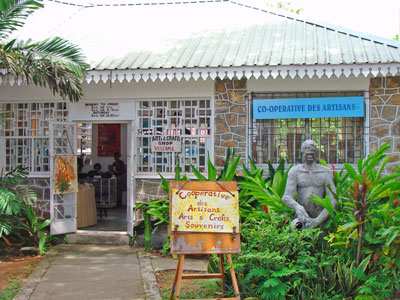


THE uniqueness of the 'Co-operative des Artisans' has endured over the 70 odd years of the existence of the association that runs it; the association of Seychelles crafts men and women. Its name has changed with time but the association has remained true to its original goals which are:
1. using only local materials, such as wood, fibres, shells pottery for their craft.
2. Encouraging the transfer of home-grown art and craft skills and knowledge through the generations, mainly within families and neighbourhoods.
3. Providing an outlet for the sale of artisanal works, which are all hand-made in Seychelles.

In fact 'handmade in Seychelles' remains the hallmark of the co-operative's products, and this has been so since the setting up of the 'Seychelles Home Industries' centre in the late 1930s, a co-operative establishment in the heart of the older part of Victoria. The modest one-storey building flanked by Barclays Bank and the law courts opens onto Independence Avenue, and its prime location ensures that it is visited by a large number of visitors to Victoria throughout the year. The co-operative shop displays and sells art and craft works produced by its 80 members who work from homes on Mahe, Praslin and La Digue. In many ways this process and the needs of local craftsmen and women have hardly changed from the time in 1937 when the annual Colonial Reports highlighted the Seychelles Home Industries as an organisation 'run by a committee of voluntary helpers' that was doing valuable work. The report noted that:
'The aim of the organization is to afford facilities, at well-known centre, for the sale of articles of home manufacture, such as tortoiseshell work, hats, sticks, needlework, island curios etc., on behalf of numerous small producers, who have hitherto found it difficult to dispose of their wares for lack of a central dept.'(p.14)
The products have evolved over time, with greater diversification of materials, improved skills, new talents and renewed energies, but the need for an outlet for artisans' wares remains. And so the co-operative serves as ever the needs of its members. Like many other small enterprises, the co-operative has faced various challenges in its time but perhaps its uniqueness, its prime location and the resilience of its members have helped it to survive. The Seychelles Home Industries managed the centre until 1988 when it was taken over by the Department of Industry, with the intention of enhancing artisanal developments and production nationally. This was and remains in line with the promotion of tourism as a major pillar of the economy.
Late 1980's Seychelles Home Industries served as the focal point during the implementation of the EU funded National Craft Project on in 1990 the Co-operative renamed “ La Boutique des Artisans” participated in the funding of a new artisanal retail centre Artisans des Iles in Camion Hall Building, Victoria. Another success story yet.
After three years under the management of the then Department of Industry, the centre, 'La Boutique des Artisans' was handed back to the association of craftspeople, and in 1992 it was re-registered as 'Lakaz Korperativ'. The co-operative has remained in the hands of the Association ever since, but the latter retains close ties with the Ministry of Industry and seeks to work in collaboration with its many other partners locally and overseas.
In 2002 'Lakaz Korperativ' renamed again as Co-operative des Artisans re-opened its doors after major renovations with an exhibition which the Association of Seychellois Craftsmen organised with the support of UNESCO. The winner of the best exhibit a member of the co-operative received a ticket to Burki-na-faso to participate in the UNESCO Best Artistic talent for Africa.
For a co-operative, collaboration is of vital importance. Through the support of the Commission de l'Ocean Indien (CIO), (the Pride project programmes) the association has developed close links with the association of artisans in Reunion and Madagascar. Members have participated in several regional craft fairs, workshops and meetings that have brought about exchanged of ideas, expertise and even of raw materials. One example is the sharing of raffia as a raw material: the Association being very much aware of its environmental responsibilities, it is supplementing its limited raffia supplies with imports from Madagascar where raffia is produced on a commercial basis. Among the Association's other collaborative ventures, is a project to promote women entrepreneurship 'Entreprendre au Feminin', also supported by the COI. Considering that many artisans and artist are women, it is important that their contribution to the industry is given enhanced value.
However, all of this would not be possible without the retail of the co-operative which enables its members to display and sell their work and showcase their talents. This was a fact acknowledged by the Seychelles Home Industries some 70 years ago, and we must not lose sight of it.
After all this has been a success story for people whose skills and craft would have otherwise remained hidden because of their work is home based.
The initiative of the Home Industries all those many years has thus become a cultural asset nationally and one to be emulated and treasured.